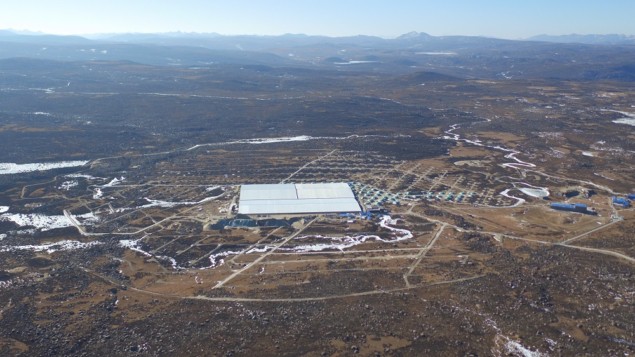Huge Chinese cosmic-ray observatory begins operation
26 Apr 2019 Michael Banks


One of the world’s largest and most sensitive cosmic-ray facilities has begun operation with its first set of detectors. Located about 4410 m above sea level in the Haizi Mountain in Sichuan Province in southwest China, the 1.2 billion yuan ($180m) Large High Altitude Air Shower Observatory (LHAASO) will attempt to understand the origins of high-energy cosmic rays.
Cosmic rays are particles that originate in outer space and are accelerated to energies higher than those that can be achieved in even the largest man-made particle accelerators. Composed mainly of high-energy protons and atomic nuclei, cosmic rays create an air shower of particles such as photons and muons when they hit the atmosphere. Where cosmic rays come from, however, has remained a mystery since they were first spotted some 100 years ago.
LHAASO aims to detect cosmic rays over a range of energies from 1011-1018 eV. The first phase of the project, which is now complete, involves 900 Cherenkov water detectors that are each equipped with two 20 cm-diameter photomultiplier tubes. The 900 units are located in a single “pool” containing 10 000 tonnes of water that is 4.5 m deep and has an area of 22 500 m2.
Being above ground, the detectors will spot the Cherenkov radiation emitted when a charged particle travels through a medium faster than light can travel through that medium. The first phase also includes two wide-field Cherenkov telescopes as well as 80 muon detectors and 180 scintillation detectors, which will study electrons and photons in the air showers.
With the first phase complete, the LHAASO will now begin studying cosmic rays as well as identifying the high-energy radiation produced by gamma-ray bursts and detect and observe extragalactic blazars. Astrophysicist Zhen Cao from the Institute of High Energy Physics (IHEP), Chinese Academy of Sciences, who is LHAASO’s chief scientist, expects that LHASSO will make breakthroughs in elucidating the origins of cosmic rays.
International collaboration
LHAASO’s water Cherenkov detector array will rival a similar experiment in Mexico — the High Altitude Water Cherenkov Experiment (HAWC), which is built mainly by the US and Mexico. HAWC detects Cherenkov radiation using 190 000 litres of extra-pure water that is contained in 300 circular water tanks each 5 m high and 7.3 m in diameter.
“LHASSO will be one of the most sensitive gamma-ray and cosmic-ray detectors in the world, not only because of its large size, but also because it uses different particle detection techniques” physicist Ibrahim Daniel Torres Aguilar, who is HAWC’s site manager, told Physics World. “Once complete it will have a better sensitivity than the HAWC observatory, however, because both observatories have a large field of view and they are on opposite longitudes, it opens the possibility that the two observatories can work together to constantly map the cosmos”.
Read more
Construction starts on huge Chinese cosmic-ray observatory
LHAASO is an international collaboration that includes scientists from China, France, Italy, Russia, Switzerland and Thailand. First mooted in 2008, the facility won approval from the National Development and Reform Commission of China in December 2015. Construction of LHAASO began in 2016 and it is set to be fully operational in 2021. When complete it will consist of a water Cherenkov detector array covering a total area of 78 000 m2, 12 wide-field Cherenkov telescopes distributed over 1.3 km2 as well as 5195 scintillation detectors and 1171 muon detectors.
IHEP director Yifang Wang says that astronomical observations have now “entered the era of combining multi-wavelength observations and multi-messenger studies,” adding that LHAASO will enhance worldwide astronomical observations.

Michael Banks is news editor of Physics World magazine
Cosmic rays are particles that originate in outer space and are accelerated to energies higher than those that can be achieved in even the largest man-made particle accelerators. Composed mainly of high-energy protons and atomic nuclei, cosmic rays create an air shower of particles such as photons and muons when they hit the atmosphere. Where cosmic rays come from, however, has remained a mystery since they were first spotted some 100 years ago.
LHAASO aims to detect cosmic rays over a range of energies from 1011-1018 eV. The first phase of the project, which is now complete, involves 900 Cherenkov water detectors that are each equipped with two 20 cm-diameter photomultiplier tubes. The 900 units are located in a single “pool” containing 10 000 tonnes of water that is 4.5 m deep and has an area of 22 500 m2.
Being above ground, the detectors will spot the Cherenkov radiation emitted when a charged particle travels through a medium faster than light can travel through that medium. The first phase also includes two wide-field Cherenkov telescopes as well as 80 muon detectors and 180 scintillation detectors, which will study electrons and photons in the air showers.
With the first phase complete, the LHAASO will now begin studying cosmic rays as well as identifying the high-energy radiation produced by gamma-ray bursts and detect and observe extragalactic blazars. Astrophysicist Zhen Cao from the Institute of High Energy Physics (IHEP), Chinese Academy of Sciences, who is LHAASO’s chief scientist, expects that LHASSO will make breakthroughs in elucidating the origins of cosmic rays.
International collaboration
LHAASO’s water Cherenkov detector array will rival a similar experiment in Mexico — the High Altitude Water Cherenkov Experiment (HAWC), which is built mainly by the US and Mexico. HAWC detects Cherenkov radiation using 190 000 litres of extra-pure water that is contained in 300 circular water tanks each 5 m high and 7.3 m in diameter.
“LHASSO will be one of the most sensitive gamma-ray and cosmic-ray detectors in the world, not only because of its large size, but also because it uses different particle detection techniques” physicist Ibrahim Daniel Torres Aguilar, who is HAWC’s site manager, told Physics World. “Once complete it will have a better sensitivity than the HAWC observatory, however, because both observatories have a large field of view and they are on opposite longitudes, it opens the possibility that the two observatories can work together to constantly map the cosmos”.
Read more

Construction starts on huge Chinese cosmic-ray observatory
LHAASO is an international collaboration that includes scientists from China, France, Italy, Russia, Switzerland and Thailand. First mooted in 2008, the facility won approval from the National Development and Reform Commission of China in December 2015. Construction of LHAASO began in 2016 and it is set to be fully operational in 2021. When complete it will consist of a water Cherenkov detector array covering a total area of 78 000 m2, 12 wide-field Cherenkov telescopes distributed over 1.3 km2 as well as 5195 scintillation detectors and 1171 muon detectors.
IHEP director Yifang Wang says that astronomical observations have now “entered the era of combining multi-wavelength observations and multi-messenger studies,” adding that LHAASO will enhance worldwide astronomical observations.

Michael Banks is news editor of Physics World magazine
physicsworld.com 26/4/2019
Δεν υπάρχουν σχόλια:
Δημοσίευση σχολίου